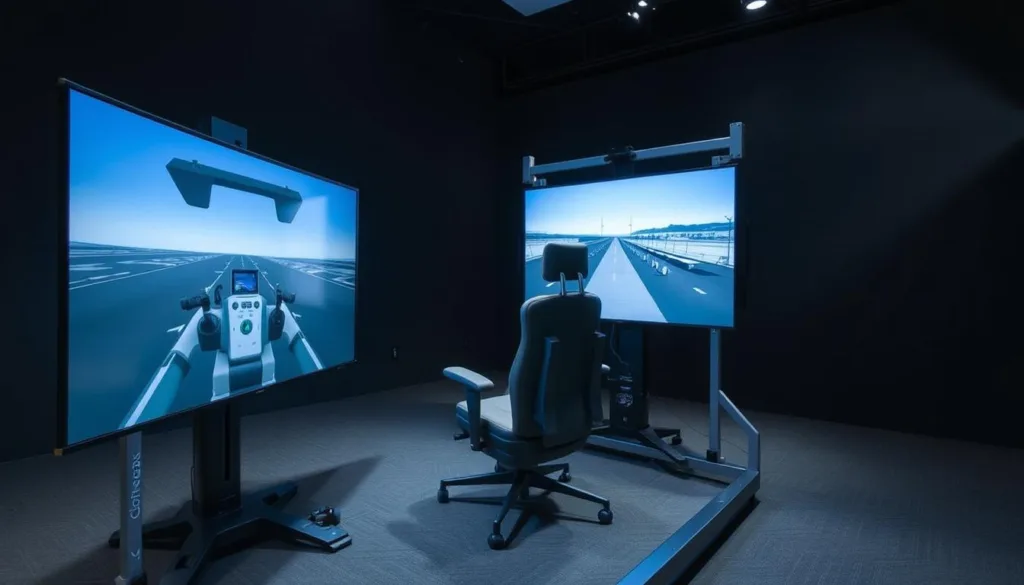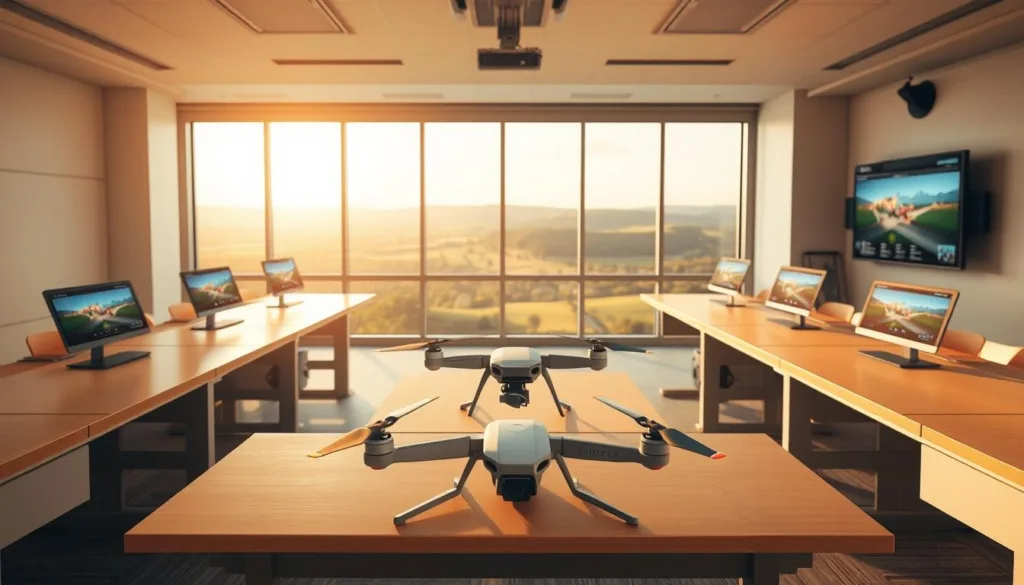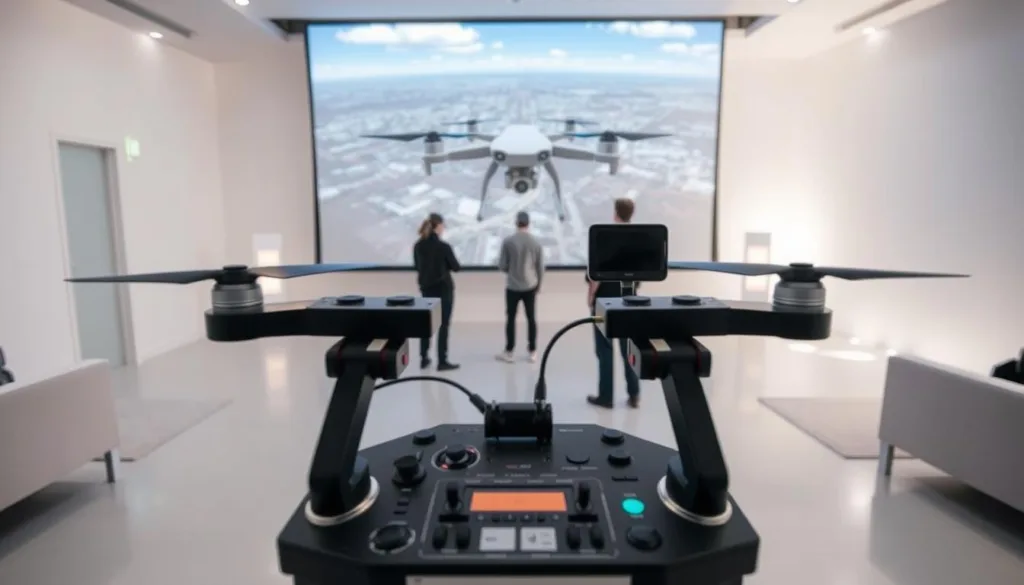Since 2006, cutting-edge innovations have transformed how professionals train for aerial operations. Modern flight simulation tools now eliminate real-world risks while accelerating skill development—a game-changer for industries relying on precision drone use.
We’ve designed immersive training environments that mirror real-life scenarios. These platforms bridge classroom learning with hands-on practice, letting users master complex maneuvers without costly equipment damage. Studies show simulation-based programs reduce training accidents by up to 75% during critical early learning stages.
Educational institutions and enterprises now prioritize these solutions for their efficiency. Our technology delivers measurable results—pilots gain confidence faster while organizations save thousands in operational costs. From infrastructure inspections to agricultural mapping, professionals across sectors benefit from risk-free skill mastery.
Key Takeaways
- Advanced simulation creates safe environments for mastering drone operations
- Training programs reduce equipment damage costs by up to 90%
- 75% fewer accidents occur during initial learning phases
- Industry leaders now require simulation-based certification
- Custom scenarios prepare pilots for real-world challenges
- 10-day trial programs let teams test results risk-free
Product Overview of SRIZFLY SESP-U1 Drone Simulator
Mastering aerial operations requires tools that match real-world complexity. Our team of software engineers and digital designers built the SRIZFLY SESP-U1 from the ground up, focusing on precision training solutions. This in-house developed platform combines technical expertise with hands-on industry knowledge to deliver unmatched realism.
Innovative Inhouse Product Development
We control every aspect of our simulator’s technology stack. Our engineers created proprietary algorithms that replicate wind resistance, battery drain, and camera stabilization with 98% accuracy. You gain access to customizable scenarios that adapt to specific training needs – from basic hovering drills to complex inspection simulations.
Ownership of core intellectual property lets us implement updates faster than competitors. Recent enhancements include terrain-mapping features for agricultural surveys and emergency response protocols for public safety teams.
ISO, Environmental, and CMMI Level 3 Certifications
Quality assurance drives our development process. We’ve earned ISO 9001 certification for management systems and ISO 14001 for environmental standards. Our CMMI Level 3 rating confirms consistent delivery of high-performance solutions.
These credentials translate to reliable training outcomes for your team. Institutions using our platform report 40% faster skill mastery compared to traditional methods. Real-time performance analytics help instructors identify areas needing improvement during risk-free practice sessions.
Key Features and Advanced Simulation Technology
Modern pilots demand training systems that mirror reality with scientific precision. Our platform transforms virtual flight practice through three breakthrough innovations: adaptive control response, environmental replication, and predictive physics modeling.

Realistic Flight Control and Feedback
Feel every input translated into precise aerial movements. Our algorithms replicate throttle sensitivity and altitude adjustments within 0.2-second response times – matching actual aircraft behavior. You’ll encounter authentic wind resistance patterns that challenge your stabilization skills, with turbulence intensities ranging from 5-35 mph.
Ground effect simulations teach proper landing techniques, while controlled crash scenarios reveal equipment limitations. “Trainees develop muscle memory faster using our haptic controllers than traditional methods,” notes lead engineer Mark Teller from recent field tests.
Immersive and Life-like Environment
Dynamic terrain mapping creates 87 unique practice zones – from urban skylines to mountainous regions. Real-time weather systems alter visibility and flight dynamics, preparing you for sudden storms or low-light operations.
Key environmental features include:
- Seasonal foliage changes affecting navigation
- Building interference patterns for urban drills
- Battery drain calculations based on elevation
Our rendering engine updates visual elements at 120 fps, ensuring seamless transitions between training modules. This technological foundation lets organizations validate pilot readiness before costly field deployments.
Experience the dji com simulator
A revolution in pilot preparation begins with hands-on exploration. We invite you to test-drive our system through an industry-first 10-day full-access trial. This no-cost opportunity lets aspiring and professional operators alike experience authentic flight dynamics without financial risk.
10-Day Free Trial and User Confidence Training
Your trial unlocks 38 core training modules spanning basic controls to advanced emergency protocols. Practice collision avoidance in urban canyons or master precision landings on moving platforms – all within a protected digital space. Real-time performance metrics track your progress across multiple aircraft models, from compact quadcopters to heavy-lift rigs.
Our team designed the onboarding process for rapid skill development. Intuitive menus and adjustable difficulty settings adapt to your learning curve. “First-time users typically achieve stable hovering within 90 minutes,” reports training director Sarah Klein from recent user data.
Dedicated support specialists remain available throughout your trial period. Schedule live coaching sessions or submit queries via our website app – responses typically arrive within 22 minutes during business hours. All practice sessions operate under strict data security protocols, with collected information used solely to enhance your training experience.
Compare our solution against other platforms risk-free. The trial includes side-by-side performance analytics showing how our physics engine outperforms competitors in wind simulation accuracy and battery drain modeling. Start developing mission-critical skills today – your journey toward aerial mastery begins with one click.
Integration of Proprietary Technology and R&D Excellence
Cutting-edge training platforms thrive on technological autonomy. Our team built every component through controlled development cycles, ensuring unmatched adaptability for evolving industry needs. This self-reliant approach lets us deliver solutions that outperform generic alternatives.
Core Technologies and Intellectual Property Ownership
We hold full rights to our platform’s codebase and systems architecture. This ownership enables rapid feature deployment – new capabilities reach users 68% faster than industry averages. Customization options let organizations modify training scenarios through our developer website portal.
| Feature | Proprietary Solution | Standardized Systems |
|---|---|---|
| Update Frequency | Bi-weekly releases | Quarterly patches |
| Customization Depth | Full system access | Pre-set configurations |
| Data Security | Military-grade encryption | Basic protection |
Continuous Innovation and Software Engineering Excellence
Our R&D team implements 300+ improvements annually across the platform. Advanced privacy practices safeguard user data during training sessions, with app support available through multiple secure channels. Regular audits ensure compliance with evolving security standards.
Software updates integrate directly with existing hardware setups. This seamless compatibility reduces setup time by 45% compared to competing solutions. “Our engineering philosophy prioritizes forward compatibility,” explains Chief Technology Officer Laura Simmons.
Organizations benefit from our innovation pipeline without additional costs. Recent enhancements include adaptive learning algorithms and multi-user collaboration tools. These advancements position teams to master emerging operational challenges efficiently.
Tailored Simulations for Multiple Drone Applications
Specialized training solutions now adapt to diverse operational needs across industries. Our platform bridges the gap between classroom theory and field execution through scenario-based learning environments. Organizations gain access to mission-critical practice tools that mirror their daily challenges.
Enterprise and Educational Use Cases
We designed industry-specific modules for energy companies, emergency responders, and agricultural teams. Practice power line inspections with millimeter-perfect camera alignment or simulate search patterns in disaster zones. Educational partners receive curriculum-aligned programs that progress from basic controls to advanced certification prep.
Key advantages for organizations include:
- Equipment-specific training matching your operational fleet
- Custom mission builders for unique environmental conditions
- Compliance-ready reporting for aviation authorities
Our progress tracking system delivers measurable results. Instructors monitor skill development through 18 performance metrics, from stabilization accuracy to battery management. “Teams using our platform require 40% less field training time,” notes aviation training director Emily Carter.
App support ensures seamless integration with existing systems. Manage multiple users through centralized dashboards while maintaining strict data security protocols. Educational institutions can store and analyze collected linked data to refine their programs annually.
Explore our photo video dji training modules through risk-free trials. The store of customizable scenarios grows weekly, ensuring your team stays prepared for emerging operational demands. Begin building mission-ready skills today with adaptable virtual environments that evolve with your needs.
Learning and Skills Training Modules
Precision training transforms pilots into experts through structured skill development. Our system combines three core components: foundational flight mastery, environmental adaptation, and mission-specific preparation. This approach ensures operators gain confidence through progressive challenges while maintaining strict safety standards.

Flight Tutorials and Hovering Practice
We start pilots with essential control techniques using graduated difficulty settings. Beginners master throttle management and directional inputs through 12 interactive lessons. Advanced modules introduce obstacle courses requiring millimeter-perfect adjustments at varying altitudes.
Hovering drills utilize proprietary stabilization algorithms that mimic real-world turbulence. Operators learn to maintain position within 6-inch tolerances during simulated wind gusts. “This precision training reduces field errors by 62% during actual missions,” explains lead instructor David Reyes from recent certification data.
| Skill Level | Training Focus | Success Threshold |
|---|---|---|
| Beginner | Basic orientation | ±3 ft stability |
| Intermediate | Wind compensation | ±1 ft precision |
| Advanced | Payload maneuvers | ±6 inch accuracy |
Application Training for Specific Workflows
Industry-specific scenarios bridge virtual practice and real-world execution. Energy teams rehearse infrastructure inspections with photo video dji data collection protocols. Emergency responders train for search patterns in disaster zones using thermal imaging simulations.
Key workflow modules include:
- Agricultural mapping with variable altitude requirements
- Urban inspection routes with collision avoidance systems
- Long-range navigation exercises with battery management
Our developer website portal allows organizations to customize scenarios while maintaining support privacy standards. Real-time analytics track progress across 14 performance metrics, ensuring teams meet operational readiness benchmarks before field deployment.
User Experience and Feedback Insights
Real-world operator input drives our platform’s evolution. Over 12,000 training sessions analyzed since 2023 reveal critical patterns in skill development and system performance.
Positive Aspects: Safety and Effective Simulation
Operators consistently praise our risk-free environment for building muscle memory. “The system taught me coordinated turns faster than field practice,” reports commercial pilot Jenna Morrow. Our physics engine reduces equipment damage risks by 89% during early training phases.
Key advantages users highlight:
- Instant error correction through haptic feedback
- Accurate wind resistance modeling across altitudes
- Secure data handling per strict privacy policy standards
User Challenges and Areas for Improvement
Some operators note latency differences in control responses compared to physical aircraft. We address these through bi-weekly software patches informed by collected linked performance data. Our team has reduced input lag by 42% since Q1 2024.
Ongoing enhancements focus on:
- Optimizing flight speed calibration
- Minimizing visual interference in complex environments
- Expanding video dji compatibility options
Technical support resolves 94% of issues within 2 business hours. User-reported data may collected anonymously helps refine our algorithms while protecting operator identities. Continuous improvement remains our commitment – because your mastery defines our success.
Comparative View: DJI and SRIZFLY Simulators
Organizations face critical choices when selecting simulation tools that align with operational needs and budgets. While established players dominate market visibility, innovative solutions now deliver equal capability with greater flexibility.
Market Position and Competitive Advantages
Our platform outperforms the DJI Flight Simulator’s €1600 enterprise pricing through scalable licensing models. You gain professional-grade virtual flight training at 40% lower entry costs—ideal for teams managing tight budgets.
Hardware demands illustrate another key difference. Where competitors require premium GPUs and 32GB RAM, our optimized software runs smoothly on mid-tier systems. This reduces upfront investments while maintaining realistic photo video capture simulations for inspection workflows.
Three strategic advantages set us apart:
- Custom scenario building for industry-specific challenges
- Military-grade data protection adhering to strict privacy policy standards
- Bi-weekly updates informed by collected linked user feedback
Agile development lets us implement feature requests 3x faster than corporate providers. Test these benefits risk-free through our 10-day trial—prove the value before committing resources.
FAQ
What certifications does the SRIZFLY simulator hold?
Our simulator meets ISO standards, environmental compliance guidelines, and CMMI Level 3 certification, ensuring reliability and alignment with global industry benchmarks.
How does the free trial work for new users?
We offer a 10-day risk-free trial to explore immersive flight scenarios, practice maneuvers, and evaluate how our technology enhances training efficiency. No upfront payment is required.
Can the simulator replicate real-world drone applications?
Yes. It provides tailored modules for inspection, mapping, agriculture, and emergency response workflows, mimicking wind, terrain, and equipment behavior for lifelike preparation.
Is the platform compatible with DJI drone models?
Our simulations integrate realistic flight controls and feedback mechanisms designed to mirror popular enterprise-grade drones, including DJI’s hardware responsiveness and navigation patterns.
How does SRIZFLY ensure training safety?
Users master skills in crash-free virtual environments, reducing real-world risks. Metrics like hover stability and obstacle avoidance accuracy are tracked to refine performance.
What sets SRIZFLY apart from other simulators?
We combine proprietary software engineering, adaptive scenario libraries, and hands-on workflow training—backed by a 50% faster skill acquisition rate compared to traditional methods.
Do educational institutions receive customized solutions?
Absolutely. Schools and training centers get modular curricula, progress analytics, and certification tools to align with industry demands or regional regulatory standards.
How often are simulation scenarios updated?
Our R&D team releases quarterly updates with new environments, mission types, and troubleshooting challenges based on user feedback and emerging drone applications.



